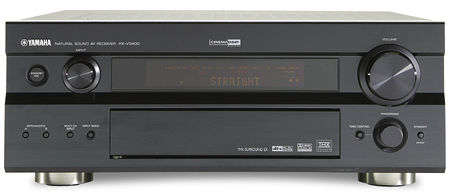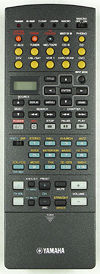Yamaha RX-V2400 A/V Receiver
Home theater has its sweet spots. In the surround sound arena, the slickest compromise between "in a box" basics and "cost no object" indulgences would have to be the $999 A/V receiver. History tells us that Yamaha has a long track record of hitting this target with one best-selling model after another. So the RX-V2400 comes with a distinguished pedigree—and THX Select certification—even without the ground-breaking addition of automatic equalization. There's nothing new in the concept of using equalization to correct flaws in room acoustics. Custom installers have been using carefully tweaked EQ for years. What's new is that the idea has trickled down from custom home theaters to bleeding-edge preamp/processors to the humble receiver.

The trickle has, in fact, become a gush. The RX-V2400 is one of three Yamaha receivers to include room correction, joining the new flagship RX-Z9 ($4,499) and the more-affordable RX-V1400 ($799). The technology is also finding its way into subwoofers and other brands of receivers.
Let's do the numbers and cherry-pick the features list. This receiver's three-digit price tag buys seven channels of amplification times a rated 120 watts with all seven channels driven simultaneously. THX Select certification ensures that it can hit a 105-decibel sound level in a room of up to 2,000 cubic feet when used with THX Select–certified speakers and remain stable when driving loads with impedances down to 3.2 ohms. With nine different crossover settings at your disposal, from 40 to 200 hertz, this receiver should mate with any sub. At 34.2 pounds, the receiver's weight is about average for this price category. The power transformer accounts for 11.9 pounds by itself. Yamaha says that the electrolytic capacitors were custom-made for this product.
On the back panel are all of the usual midpriced-receiver staples. These include nine pairs of collared binding posts, a six-channel input for a DVD-Audio or SACD player, a 7.1-channel out to mate with a separate power amp, and various multizone options. The back panel also sports a pair of wire-clip terminals with two possible uses: They can feed either a second zone or two presence speakers (in Yamaha-speak) located behind the front left and right speakers. The presence channels are active when Yamaha's Cinema DSP supplements regular Dolby Digital or DTS surround programming.
On the video side, Yamaha provides two component video inputs and one output, all of which have a 60-megahertz bandwidth. More unusual are the video conversions that eliminate the need for multiple connections between the receiver and your TV. If the receiver feeds your TV a component video connection, for example, it will also translate anything that's plugged into its composite or S-video inputs to the component video monitor-out. Composite and S-video are also interchangeable.
Three knobs on the front panel (knobs, I love knobs) make it easy to adjust volume, input, or surround mode with a few quick spins. The volume knob works in either precise half-decibel increments or larger ones, depending on the velocity of the spin. Styling is traditional Yamaha, complete with the familiar amber display, which stirs primordial yearnings in anyone who's used a Yamaha product during the last 20 years. The learning remote includes a tiny backlit LCD window, also in Yamaha-amber, that lights up to show the current input.
While the RX-V2400 automates several setup operations—including the room-correction circuit—I chose to run through them manually, the old-fashioned way, before letting the receiver break in. The clarity and detail of Yamaha's signature sound came through immediately during the first weekend. Refinement, as usual, came after a few days.

Now it was time to play with YPAO: the Yamaha Parametric Room Acoustic Optimizer. The RX-V2400 uses a 32-bit/96-kilohertz YSS-930 chip for YPAO processing and bass management. (The RX-Z9 has four chips dedicated to YPAO, allowing more bands of EQ and other subtleties.) Room correction is just one of YPAO's five talents. It also checks for missed speaker connections, sets speaker distance, tests each speaker to determine its size, and sets levels. To do all of this, you need to use a small, supplied microphone that's shaped like a chocolate kiss. Place the mike in the main listening position and plug it into the mono mini-jack on the receiver's front panel.
I set up the mike on a tripod, taking advantage of its threaded insert, and ran through YPAO a few times. The first time out, I went for all five functions. A cornucopia of test tones poured out of my system. Besides the familiar hiss of pink noise, there was also a quiet thump, something that sounded like a tock without a tick, and a brief high-frequency sweep that might double as a cartoon sound effect.
YPAO's EQ can average the frequency response of low, mid, or high frequencies, emphasizing the correction in one of those areas. If your front speakers are better than the rest, it can tailor the other speakers' response to blend with the fronts. Since my speakers were a fully matched set, I used the flat setting, which averages frequency response for all of the speakers.
Conditions weren't perfect. At one point, YPAO refused to accept the settings and gave me a succinct error message: noisy. I had silenced the air conditioner and window fan but couldn't do anything about the medley of urban noises or my DLP projector's low whoosh—I needed it to see the menus.
YPAO added an average gain of 1 dB to the front channels and an average of 2 dB to both the surround and rear channels. It shifted side-to-side balances slightly, knocked my two subs down several decibels, and designed a custom EQ scheme for each channel. It also hit a few bumps. The surround-speaker distances were off by a few feet, probably because I aim my surrounds at the ceiling to compensate for their extreme proximity to the sofa. More disturbing was that YPAO had designated my front left and right speakers as small and the other five as large, despite the fact that all of my Paradigm Reference Studio 20s are identical clones. The Studio 20 is a full-range speaker; YPAO should have identified all of the speakers as large.
I re-entered the manual-setup menu and reset all of the speakers as small (as THX recommends). Because the speaker sizes may have influenced the EQ and level-setting routines, I ran them both a second time. Incidentally, the auto-setup menu lets you omit anything that you'd rather not set up automatically, gives you a chance to accept or reject individual settings, and will even pause to let you take notes before finalizing the settings. That flexibility should make YPAO more palatable to advanced users.
 Having finally biffed, bammed, and YPAOed my system to my satisfaction, I took stock of the results. The equalizer settings were all over the map (like an average room, no doubt). Most channels got seven adjustments, the maximum number of parameters allowed by the RX-V2400's equalizer, but a few got just three or four. Pluses outnumbered minuses by about three to one, suggesting that my room has more notches than peaks. The lower midrange got the most boosting, especially at 630 Hz and below, while the heaviest cuts came in the high-frequency bands, especially at 10 kHz and 13 kHz.
Having finally biffed, bammed, and YPAOed my system to my satisfaction, I took stock of the results. The equalizer settings were all over the map (like an average room, no doubt). Most channels got seven adjustments, the maximum number of parameters allowed by the RX-V2400's equalizer, but a few got just three or four. Pluses outnumbered minuses by about three to one, suggesting that my room has more notches than peaks. The lower midrange got the most boosting, especially at 630 Hz and below, while the heaviest cuts came in the high-frequency bands, especially at 10 kHz and 13 kHz.
This warmed up the overall tonal balance. Brightness diminished, which was immediately apparent on violin-centered recordings like Dave Swarbrick's folk-rock masterpiece Smiddyburn and works of Debussy and Ravel performed by the Tokyo String Quartet. I found myself turning up the master volume, which in turn enlarged and strengthened the Pro Logic II and Neo:6 soundfields. While dyed-in-wool Yamaha buffs might have found the sound to be blander, it was also smoother and less fatiguing.
So, yes, I found comfort in YPAO. Was it more accurate? There's a school of thought that says room EQ causes undesirable side effects, and I have no way of knowing how much the correction circuit reacted to the speakers, as opposed to the room. I do know that music sounded better after correction than it did before.
It worked with movies, too, including the THX-approved DVD of X-Men 1.5 in DTS 5.1 (or 5.2 in my system). The opening scene and the truck demolition were spectacularly loud, even after I knocked the master volume down to 10 dB below the THX reference level. Engaging the THX circuit made the high volumes easier to take as the blare-reducing Re-EQ kicked in. I was also impressed by the way the Yamaha handled low-level resolution in the sotto voce conversation between Patrick Stewart and Ian McKellen in the halls of Congress.
For a rear-channel workout, I turned to The Lord of the Rings: The Fellowship of the Ring and its sequel, The Two Towers. The music and X-Men demos had left me wondering whether the subwoofer channel was a little too quiet, but it acquired some measured menace in Peter Jackson's epic. Fellowship slowly ramps up its use of the rear channels, using them sparingly in the opening scenes, a bit more in the Hobbiton fireworks display, and most heavily in the later action extravaganzas. The Two Towers, a nonstop war cartoon, is far less subtle in that respect. As I switched back and forth between the DTS ES and Dolby EX soundtracks—both of which are rich in orchestral textures and painterly sound effects—I couldn't help but fall in love with the whole concept of home theater all over again.
And that says it all. With the RX-V2400, Yamaha delivers THX certification, the latest in surround decoding, enough power to drive reasonably sensitive speakers to ear-pinning levels, and a room-correction circuit that breaks into new (and I'd say improved) sonic territory. Droolers will love the receiver's tweaky features, but it's also good enough to seduce those who have resisted surround sound technology up till now. Home theater couldn't have a better diplomat.
* Mark Fleischmann is the author of Practical Home Theater, available through www.practicalhometheater.com (or 800/839-8640).
Highlights
• Rarities like parametric EQ and video conversion
• Seven channels of 120-watt joy—and no cheating
• Still uses the good old amber display

- Log in or register to post comments






























































